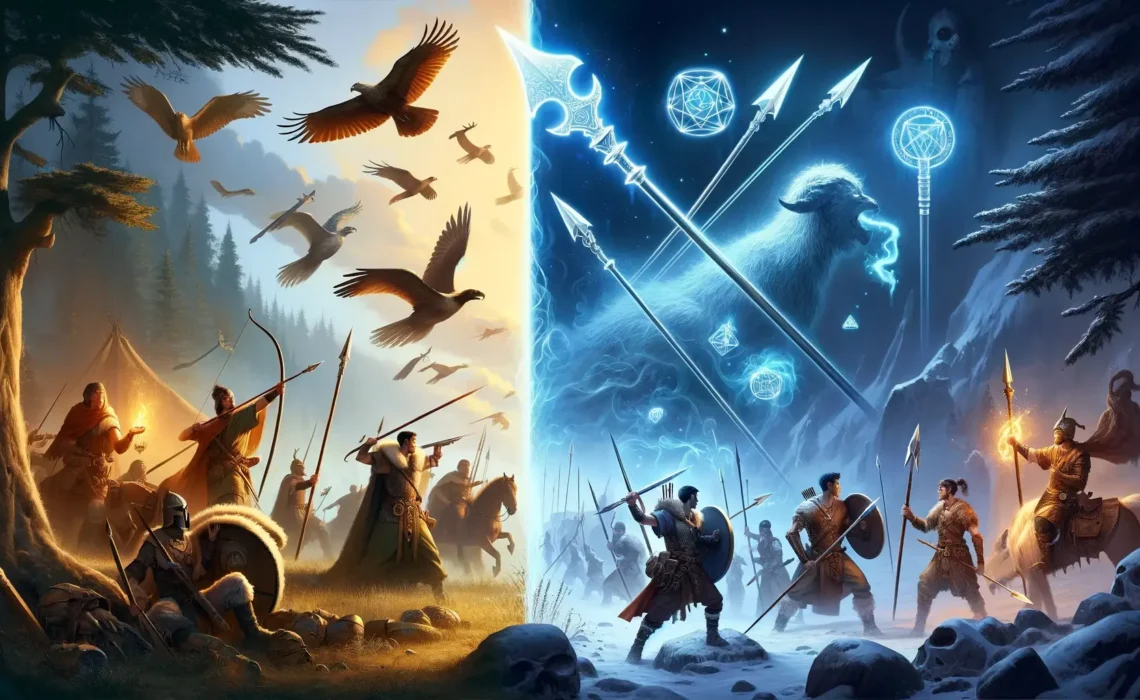Among the different arsenals accessible to adventurers in Dungeons & Dragons 5th Edition (D&D 5e), the javelin rests in a niche area. It embodies a cross between the precision of ranged weaponry and the loud, bloody edge of melee battle, offering flexibility and strategic depth that could turn the tide of battle.
This guide aims to explore the nuances of wielding a javelin, ensuring that both pro players and newcomers can grasp its use.
Table of Contents
Introduction to the Javelin
Javelins in D&D 5e are more than simple spears; they show the innovation of warriors over many years. Javelins have a background that was traced from their roots to the low back: in history, they were used as hunting implements and weapons. Javelins are a favorite weapon inside the delusion realm of D&D, maintaining their historical significance while gaining magical potential. This mixture of history and myth makes the javelin a captivating weapon choice for adventurers.
Javelin Mechanics and Features
The Javelin is a simple melee weapon, thus being readily available for anybody to use as part of their training. It inflicts 1d6 piercing damage with a range of 30/120 feet, effective at both melee and ranged attack. Weighing only 2 kilograms, it is light enough to be carried in multiples, ensuring that adventurers always have a javelin ready. Its vital, versatile characteristic makes it a preferred choice for attacking distant enemies or engaging enemies at close quarters.
Wielding a Javelin: Basics to Mastery
Basic Use
At its core, the javelin can be used to make ranged assaults against objectives within its throw variety. For close fights, it has capabilities as a melee weapon. Adventurers need to usually understand their surroundings and the positioning of allies and enemies to maximize the effectiveness of their javelin throws.
Advanced Techniques
Mastery of the javelin includes understanding its twin nature. Skilled users can switch between melee and ranged assaults because of the scenario needs. Incorporating motion to maintain ultimate distance from enemies, aiming for vulnerabilities, and retrieving thrown javelins whilst possible are all marks of an adept javelin wielder.
Javelins Across Character Classes
While traditionally associated with warriors, javelins can be effectively used by several classes. Fighters can use javelins to engage foes earlier than last in for melee combat, and rangers can add javelins to their repertoire of ranged weapons for situations in which arrows might not be the best choice.
Even classes with spellcasting features, like druids or clerics, who have proficiency in simple weapons, might find javelins useful for their versatility or as a backup for conserving spell slots.
Optimizing Javelin Use in Your Campaign
Adventurers looking to optimize their use of javelins can not forget numerous strategies:
- Feats and Skills: The “Sharpshooter” feat may be beneficial for javelin users, permitting them to ignore lengthy-range consequences and cowl blessings. Similarly, enhancing one’s Strength score complements both the assault and damage rolls of javelin throws.
- Magic Javelins: Seek out magical javelins, which provide superior harm, accuracy, or maybe precise skills like returning to the thrower’s hand.
Creative Uses of Javelins Beyond Combat
Beyond their application in warfare, javelins can serve a number of innovative purposes:
- Problem Solving: Use a javelin to trigger traps from a safe distance, and create makeshift bridges, or stable ropes for hiking.
- Roleplaying Opportunities: Javelins may be a part of cultural or ceremonial practices for an individual, adding intensity to their backstory and interactions.
By embracing the javelin’s potential inside and outside of combat, adventurers can liberate new dimensions of gameplay and storytelling. Whether used to fall enemy, resolve a difficult puzzle, or as a symbol of a person’s background, the javelin remains a flexible and compelling preference for any D&D marketing campaign.
Read more: 5e Point Buy Calculator
Famous Javelins and Their Wielders in D&D Lore
The annals of Dungeons and Dragons lore are filled with reminiscences of mythical javelins wielded by heroes and villains alike, each with its own personal tale to tell. One of such artifacts is the Javelin of Lightning, a magical weapon that transforms into a bolt of lightning when thrown, with the might of a thunderstorm. Another notable weapon is the Piercing Javelin, aptly named for its ability to breach through magical barriers and armors with ease. These fabled armaments inspire adventurers to pursue their own mythic javelins, bringing added depth and backstory to their journeys.
Crafting and Acquiring Javelins in 5e
Javelin acquisition can be done in many ways, from purchasing them on the market or at the armory to looting them from dead enemy soldiers. On the other hand, when a javelin is crafted, a much more personal connection to the weapon is felt.
Characters who own the “Smithing” node are allowed to spend enough time and resources to forge a javelin, which can have special markings, or maybe even minor enchantments. It is an opportunity to give the character not just a utilitarian weapon but a part of the story about the character himself.
DM Tips: Incorporating Javelins into Your Game
A truly discerning Dungeon Master may elect to add javelins to encounters and storylines in his or her game. It could be introduced in the form of a quest reward or part of the plot device, igniting excitement and engrossment in the players.
From battles on rough terrain to even adding flying enemies, the design of encounters with such wide varieties can truly bring out the versatility of a javelin in terms of combat styles. Adding cultures or factions known for their javelin mastery will even add richness to the game world.
FAQs: Mastering the Art of the Javelin
Q: Can javelins be used with two-weapon combating?
A: Javelins are not light guns, so they do not certainly qualify for two-weapon combating. However, particular class features or feats would possibly permit a person to efficaciously wield a javelin in one hand and some other weapon in the other.
Q: How do I retrieve a thrown javelin?
A: A thrown javelin can be retrieved with the aid of spending movement to attain its touchdown spot. DMs may additionally rule that retrieving a javelin for the duration of combat calls for a movement or a part of a movement, depending on the situation.
Q: Can javelins be enchanted with spells?
A: Yes, javelins can be enchanted like any other weapon. Spells like Magic Weapon can briefly enhance a javelin, whilst greater permanent enchantments may be applied by using professional enchanters.
Conclusion: The Javelin’s Place in D&D 5e
Within the grand tapestry of D&D 5e, the javelin represents something even more than an imaginative instrument; rather, it is a sign of adroitness, travel, and the forging bond between a warrior and his chosen armament. Whether used by a veteran to bring the dragon low or in the hands of a nimble rogue to disarm a lethal trap, the javelin has a place of honor in an adventurer’s arsenal. Adaptability and development to the various contexts of combat, and creativity: these two features make it a sort of staple for anyone trying to get into the whole of D&D in its depth.
As players and Dungeon Masters alike continue to explore the giant worlds of D&D, this javelin stands as a classic reminder that simplicity and intensity are elements that can find a home even in some of the most basic weapons.



